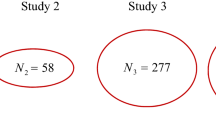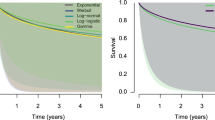Abstract
Targeted maximum likelihood estimation (TMLE) provides a general methodology for estimation of causal parameters in presence of high-dimensional nuisance parameters. Generally, TMLE consists of a two-step procedure that combines data-adaptive nuisance parameter estimation with semiparametric efficiency and rigorous statistical inference obtained via a targeted update step. In this paper, we demonstrate the practical applicability of TMLE based causal inference in survival and competing risks settings where event times are not confined to take place on a discrete and finite grid. We focus on estimation of causal effects of time-fixed treatment decisions on survival and absolute risk probabilities, considering different univariate and multidimensional parameters. Besides providing a general guidance to using TMLE for survival and competing risks analysis, we further describe how the previous work can be extended with the use of loss-based cross-validated estimation, also known as super learning, of the conditional hazards. We illustrate the usage of the considered methods using publicly available data from a trial on adjuvant chemotherapy for colon cancer. R software code to implement all considered algorithms and to reproduce all analyses is available in an accompanying online appendix on Github.







Similar content being viewed by others
References
Andersen PK, Borgan O, Gill RD, Keiding N (1993) Statistical models based on counting processes. Springer, New York
Benkeser D, Carone M, Gilbert PB (2018) Improved estimation of the cumulative incidence of rare outcomes. Stat Med 37(2):280–293
Benkeser D, van der Laan M (2016) The highly adaptive lasso estimator. In: Proceedings of the... International conference on data science and advanced analytics. IEEE international conference on data science and advanced analytics, NIH Public Access, vol 2016, p 689
Bibaut AF, van der Laan MJ (2019) Fast rates for empirical risk minimization over càdlàg functions with bounded sectional variation norm. arXiv e-prints arXiv:1907.09244, 1907.09244
Bickel PJ, Klaassen CAJ, Ritov Y, Wellner JA (1993) Efficient and adaptive inference in semiparametric models. Indian J Stat 62:157–160
Cai W, van der Laan MJ (2019) One-step targeted maximum likelihood estimation for time-to-event outcomes. Biometrics 76(3):722–733
Cox DR (1972) Regression models and life-tables. J R Stat Soc: Ser B (Methodol) 34(2):187–202
Cox DR (1975) Partial likelihood. Biometrika 62(2):269–276
Friedman J, Hastie T, Tibshirani R (2010) Regularization paths for generalized linear models via coordinate descent. J Stat Softw 33(1):1–22
Gill RD, van der Laan MJ, Wellner JA (1995) Inefficient estimators of the bivariate survival function for three models. Annales de l’Institut Henri Poincaré 31:545–597
Gill RD, Robins JM (2001) Causal inference for complex longitudinal data: the continuous case. Ann Stat 29:1785–1811
Gray RJ (1988) A class of \(k\)-sample tests for comparing the cumulative incidence of a competing risk. Ann Stat 16(3):1141–1154
Hernán MA (2010) The hazards of hazard ratios. Epidemiology 21(1):13
Hernan MA, Robins JM (2020) Causal inference. Chapman & Hall/CRC, Boca Raton
Hubbard AE, van der L MJ, Robins JM (2000) Nonparametric locally efficient estimation of the treatment specific survival distribution with right censored data and covariates in observational studies. In: Statistical models in epidemiology, the environment, and clinical trials, Springer, Berlin, pp 135–177
Martinussen T, Vansteelandt S, Andersen PK (2018) Subtleties in the interpretation of hazard ratios. arXiv preprint arXiv:1810.09192
Moertel CG, Fleming TR, Macdonald JS, Haller DG, Laurie JA, Goodman PJ, Ungerleider JS, Emerson WA, Tormey DC, Glick JH, Veeder MH, Mailliard JA (1990) Levamisole and fluorouracil for adjuvant therapy of resected colon carcinoma. N Engl J Med 322(6):352–358
Moertel CG, Fleming TR, Macdonald JS, Haller DG, Laurie JA, Tangen CM, Ungerleider JS, Emerson WA, Tormey DC, Glick JH, Mailliard JA (1995) Fluorouracil plus levamisole as effective adjuvant therapy after resection of stage III colon carcinoma: a final report. Ann Intern Med 122(5):321–326
Moore KL, van der Laan MJ (2009) Application of time-to-event methods in the assessment of safety in clinical trials. In: Design and analysis of clinical trials with time-to-event endpoints. Taylor & Francis, London, pp 455–482
Moore KL, van der Laan MJ (2009) Covariate adjustment in randomized trials with binary outcomes: targeted maximum likelihood estimation. Stat Med 28(1):39–64
Moore KL, van der Laan MJ (2009) Increasing power in randomized trials with right censored outcomes through covariate adjustment. J Biopharm Stat 19(6):1099–1131
Murphy SA (1995) Likelihood ratio-based confidence intervals in survival analysis. J Am Stat Assoc 90(432):1399–1405
R Core Team (2020) R: a language and environment for statistical computing. R Foundation for Statistical Computing, Vienna, Austria https://www.R-project.org/
Robins JM, Rotnitzky A (1992) Recovery of information and adjustment for dependent censoring using surrogate markers. In: AIDS epidemiology, Springer, Berlin pp 297–331
Robins J (1986) A new approach to causal inference in mortality studies with a sustained exposure period-application to control of the healthy worker survivor effect. Math Model 7(9–12):1393–1512
Rytgaard HCW, Eriksson F, van der Laan MJ (2021b) Estimation of time-specific intervention effects on continuously distributed time-to-event outcomes by targeted maximum likelihood estimation. arXiv preprint arXiv:2106.11009
Rytgaard HCW, van der Laan MJ (2021) One-step tmle to target cause-specific absolute risks and survival curves. arXiv preprint arXiv:2107.01537
Rytgaard HC, Gerds TA, van der Laan MJ (2021a) Continuous-time targeted minimum loss-based estimation of intervention-specific mean outcomes. Annals of Statistics (just accepted)
Simon N, Friedman J, Hastie T, Tibshirani R (2011) Regularization paths for cox’s proportional hazards model via coordinate descent. J Stat Softw 39(5):1
Stitelman OM, van der Laan MJ (2011) Targeted maximum likelihood estimation of time-to-event parameters with time-dependent covariates. Division of Biostatistics, University of California, Berkeley, Technical report
Stitelman OM, Wester CW, De Gruttola V, van der Laan MJ (2011) Targeted maximum likelihood estimation of effect modification parameters in survival analysis. Int J Biostat 7(1):1–34
Therneau TM (2015) A package for survival analysis in S. https://CRAN.R-project.org/package=survival, version 2.38
Tibshirani R (1997) The lasso method for variable selection in the cox model. Stat Med 16(4):385–395
van der Laan MJ (2006) Statistical inference for variable importance. Int J Biostat. https://doi.org/10.2202/1557-4679.1008
van der Laan MJ (2017) A generally efficient targeted minimum loss based estimator based on the highly adaptive lasso. Int J Biostat. https://doi.org/10.1515/ijb-2015-0097
van der Laan MJ, Dudoit S (2003) Unified cross-validation methodology for selection among estimators and a general cross-validated adaptive epsilon-net estimator: finite sample oracle inequalities and examples
van der Laan MJ, Gruber S (2012) Targeted minimum loss based estimation of causal effects of multiple time point interventions. Int J Biostat. https://doi.org/10.1515/1557-4679.1370
van der Laan M, Gruber S (2016) One-step targeted minimum loss-based estimation based on universal least favorable one-dimensional submodels. Int J Biostat 12(1):351–378
van der Laan MJ, Robins JM (2003) Unified methods for censored longitudinal data and causality. Springer, Berlin
van der Laan MJ, Rubin D (2006) Targeted maximum likelihood learning. Int J Biostat 2(1):1043–1043
van der Laan MJ, Rose S (2011) Targeted learning: causal inference for observational and experimental data. Springer, Berlin
van der Laan MJ, Rose S (2018) Targeted learning in data science: causal inference for complex longitudinal studies. Springer, Berlin
van der Laan MJ, Dudoit S, Keles S (2004) Asymptotic optimality of likelihood-based cross-validation. Stat Appl Genet Mol Biol. https://doi.org/10.2202/1544-6115.1036
van der Laan MJ, Polley EC, Hubbard AE (2007) Super learner. Stat Appl Genet Mol Biol. https://doi.org/10.2202/1544-6115.1309
van der Vaart AW (2000) Asymptotic statistics, vol 3. Cambridge University Press, Cambridge
van der Vaart AW, Wellner JA (1996) Weak convergence. In: Weak convergence and empirical processes. Springer, Berlin, pp 16–28
van der Vaart AW, Dudoit S, van der Laan MJ (2006) Oracle inequalities for multi-fold cross validation. Stat Decis 24(3):351–371
Westling T, van der Laan MJ, Carone M (2020) Correcting an estimator of a multivariate monotone function with isotonic regression. Electr J Stat 14(2):3032–3069
Author information
Authors and Affiliations
Corresponding author
Additional information
Publisher's Note
Springer Nature remains neutral with regard to jurisdictional claims in published maps and institutional affiliations.
Rights and permissions
Springer Nature or its licensor (e.g. a society or other partner) holds exclusive rights to this article under a publishing agreement with the author(s) or other rightsholder(s); author self-archiving of the accepted manuscript version of this article is solely governed by the terms of such publishing agreement and applicable law.
About this article
Cite this article
Rytgaard, H.C.W., van der Laan, M.J. Targeted maximum likelihood estimation for causal inference in survival and competing risks analysis. Lifetime Data Anal 30, 4–33 (2024). https://doi.org/10.1007/s10985-022-09576-2
Received:
Accepted:
Published:
Issue Date:
DOI: https://doi.org/10.1007/s10985-022-09576-2




